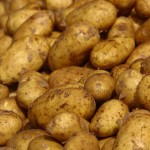Budget-saving spuds
 Potatoes are thought to date back about 2500 years and been a staple for many civilisations. Fortunately modern households are not as dependant on them as was once the case, so a potato crop failure in your back garden is not likely to have the fatally rebellious consequences of old!
Potatoes are thought to date back about 2500 years and been a staple for many civilisations. Fortunately modern households are not as dependant on them as was once the case, so a potato crop failure in your back garden is not likely to have the fatally rebellious consequences of old!
The good thing about spuds is that they cost next to nothing to grow and are cheap to buy. Let’s deal with the growing basics.
Potatoes will grow in all areas of New Zealand. Plant in a space with full sun when the weather starts to warm in early spring.
Rotate planting or mix varieties to produce a continual harvest period.
They are grown from seed potatoes, which are cut into pieces with two or three shoots (eyes) on each. Leave the pieces in a warm place for a couple of weeks to allow the cuts to dry and the shoots to sprout. Seed potatoes are cheapest at garden centres, but some oily raggers use leftover spuds rather than toss them out.
Being a root vegetable, spuds do best in loose soil rich. Plant the seed potato pieces about 50mm deep with the sprouts facing up. Lightly cover with soil or mulch. As the plants grow, mound the soil or straw over the rows to form a raised bed about 150mm high. This provides a loose medium for the roots to spread and makes it easy to dig out the mature potatoes. Water regularly.
Harvest new potatoes about 3 or 4 weeks after flowering. Dig up the main crop after the tops have died down. Store the spuds for at least 10-14 days in a dark, well-ventilated place. You should get between 1 and 2 kilos per plant.
Most people have a favourite potato recipe. Here are some no-nonsense ways to make a tasty potato based meal.
· Baked potatoes. Scrub potatoes and dry thoroughly
– the sound of grit grinding between one’s molars is most unpleasant!
Bake at around 200 C for about 45 minutes or until the potatoes are soft. Remove from oven (a quick zap in the microwave will also do the trick) and cut a cross in the top. Press the sides to open up the cut, and place a knob of butter and a dash of seasoning into the centre. You can also top them with whatever takes your fancy – grated cheese, cream cheese, cottage cheese, sour cream, chopped chives, chopped mint, chopped parsley, chopped thyme, chopped spring onion, chopped gherkins, chopped green or red pepper.
· Stuffed baked potatoes. Once the potatoes have been
baked, scoop out the flesh and mix it with any one of a number or combination of fillings: egg; cheese; baked beans; cooked mince; fish; vegetables; grated cheese and chopped chives; tinned salmon and lemon juice; sour cream and chopped red pepper; plain unsweetened yoghurt and fried chopped onion; chopped cooked spinach and grated cheese; in fact anything you happen to have handy.
Pile the filling back into the potato cases and place back into a hot oven until heated through.
· Mashed potatoes. A quick and easy dish is made from
cooked and mashed potatoes. Add ½ finely chopped onion to the mashed potato and place this mixture in a serving dish. Sprinkle with grated cheese and grill until lightly browned. There are any number of seasonings and “additives” that can make mashed spuds into something a little different. Try chopped fresh herbs such as chives, dill, parsley, rosemary or tarragon; raw or sautéed green or red pepper; crushed garlic.
Share your favourite potato recipes by visiting www.oilyrag.co.nz.
* Frank and Muriel Newman are the authors of Living off the Smell of an Oily Rag in NZ. Readers can submit their oily rag tips on-line at www.oilyrag.co.nz. The book is available from bookstores and online at www.oilyrag.co.nz.

